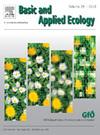The global conservation status of plants growing on cliffs and rocky outcrops
IF 3.5
2区 环境科学与生态学
Q2 ECOLOGY
引用次数: 0
Abstract
Ecosystems that occur on cliffs and rocky outcrops are home to many plants that are specially adapted to harsh environmental conditions. These habitats are seeing increased pressure from development, recreational use, and invasive species, calling for a thorough evaluation of the endangerment of the taxa inhabiting them. However, the conservation status of these taxa is not well understood preventing effective conservation prioritization and action. In this study, we examine the conservation status of vascular plant taxa associated with these ecosystems, using the International Union for Conservation of Nature (IUCN) Red List of Threatened Species assessments, and compare these to their taxonomic status (families and genera) and range (realm, country, occupancy). We have assembled data highlighting regions where cliff and rocky outcrop taxa most frequently occur (Madagascar, Brazil, Spain) and found that plants growing in these habitats may be more endangered than expected given global plant endangerment, however, risk patterns do vary. Certain groups find refuge in cliffs or rocky outcrops environments (Euphorbiaceae, 18% less endangered), while others may be facing increased risk (Cactaceae, 19% more endangered). We have also found that taxa occurring in habitats with low mean elevation or narrow elevational ranges are more endangered. To assist future research, we have developed a dashboard summarizing available data that also allows for interactive analyses based on user-defined goals. We see the need for additional research on cliff and rocky outcrop plants to enhance the Red List assessment process and support overall plant conservation efforts.
生长在悬崖和露头岩石上的植物的全球保护状况
发生在悬崖和露出地面的岩石上的生态系统是许多特别适应恶劣环境条件的植物的家园。这些栖息地正面临着来自开发、娱乐用途和入侵物种的越来越大的压力,需要对栖息在这些栖息地的分类群的濒危进行彻底的评估。然而,这些分类群的保护现状尚不清楚,影响了有效的保护优先级和保护行动。本研究利用国际自然保护联盟(IUCN)濒危物种红色名录对与这些生态系统相关的维管植物分类群的保护状况进行了研究,并与它们的分类状况(科、属)和范围(领域、国家、占用)进行了比较。我们收集了突出显示悬崖和岩石露头分类群最频繁出现的地区(马达加斯加、巴西、西班牙)的数据,发现在这些栖息地生长的植物可能比全球植物濒危的预期更为濒危,然而,风险模式确实有所不同。某些种群在悬崖或岩石露头环境中找到避难所(大戟科,濒危程度降低18%),而其他种群可能面临更大的风险(仙人掌科,濒危程度增加19%)。研究还发现,平均海拔较低或海拔范围较窄的生境中存在的类群更为濒危。为了协助未来的研究,我们开发了一个仪表板,汇总可用数据,还允许基于用户定义的目标进行交互式分析。我们认为有必要进一步研究悬崖和岩石露头植物,以加强红色名录的评估过程,并支持整体的植物保护工作。
本文章由计算机程序翻译,如有差异,请以英文原文为准。
求助全文
约1分钟内获得全文
求助全文
来源期刊

Basic and Applied Ecology
环境科学-生态学
CiteScore
6.90
自引率
5.30%
发文量
103
审稿时长
10.6 weeks
期刊介绍:
Basic and Applied Ecology provides a forum in which significant advances and ideas can be rapidly communicated to a wide audience. Basic and Applied Ecology publishes original contributions, perspectives and reviews from all areas of basic and applied ecology. Ecologists from all countries are invited to publish ecological research of international interest in its pages. There is no bias with regard to taxon or geographical area.
 求助内容:
求助内容: 应助结果提醒方式:
应助结果提醒方式:


